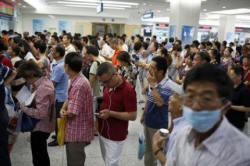|
 China
aims to double doctor numbers as cure for healthcare
woes China
aims to double doctor numbers as cure for healthcare
woes
 Send a link to a friend
Send a link to a friend
[March 31, 2015]
By Adam Jourdan
SHANGHAI (Reuters) - China will almost
double the number of its general doctors by 2020, trim its public sector
and improve technology as it seeks to fix a healthcare system plagued by
snarling queues and poor rural services, its main administrative
authority has said.
|
|
 China's fast-growing healthcare market is a magnet for global drug
makers, medical device firms and hospital operators, all looking to
take a slice of a healthcare bill expected to hit $1 trillion by
2020, according to McKinsey & Co. China's fast-growing healthcare market is a magnet for global drug
makers, medical device firms and hospital operators, all looking to
take a slice of a healthcare bill expected to hit $1 trillion by
2020, according to McKinsey & Co.
"Healthcare resources overall are insufficient, quality is too low,
our structures are badly organized and service systems fragmented.
Parts of the public hospital system have also become bloated,"
China's State Council said in a five-year roadmap announced late on
Monday.
The roadmap, which laid out targets for healthcare officials
nationwide between 2015 and 2020, said Beijing wanted to have two
general doctors per thousand people by 2020, close to double the
number at the end of 2013, as well as increasing the number of
nursing and support staff.

China suffers from a scarcity of doctors - partly caused by low
salaries - which has created bottlenecks at popular urban hospitals
leading to rising tension between medical practitioners and often
frustrated patients.
The roadmap said China would also look to use technology such as
mobile devices and online "cloud systems" to meet some of the
issues, a potential boost to tech firms like Alibaba Group Holding
Ltd and its healthcare subsidiary Alibaba Health Information
Technology Ltd.
China should also have digital databases for electronic health
records and patient information covering the entire population to
some degree by 2020, it said.
Providing access to affordable healthcare is a key platform for
President Xi Jinping's government. However, recent probes have
turned the spotlight on corruption in the sector, while patients
often have large out-of-pocket expenses due to low levels of
insurance coverage.
[to top of second column] |

The roadmap said China would push forward the development of
grassroots healthcare, a fast-growing business segment, while
reining in some large public hospitals in urban centers.
The document also suggested further opening to the private sector,
where Chinese and international firms have been taking a growing
role in running hospitals.
"The role of public health institutions is too big, with the number
of beds accounting for around 90 percent of the total," the State
Council said.
(Editing by Paul Tait)
[© 2015 Thomson Reuters. All rights
reserved.] Copyright 2015 Reuters. All rights reserved. This material may not be published,
broadcast, rewritten or redistributed.

 |